Ancient Egypt Cats Thanks for Watching Word Art Egypt
The dog equally "human's all-time friend" has a long history going dorsum to the ages long before the civilization of ancient Arab republic of egypt was established merely the Egyptians were amongst the primeval people to recognize the value of the canis familiaris and show their appreciation for its item skills and talents.
Aboriginal Egypt is well known for its association with cats but the dog was as popular and highly regarded. Egyptologist Margaret Bunson notes that dogs "were probably domesticated in Egypt in the Pre-Dynastic eras" and they "served as hunters and equally companions for the Egyptians and some mentioned their hounds in their mortuary texts" (67). An early tomb painting dated to c. 3500 BCE shows a man walking his dog on a leash in a scene recognizable to anyone in the modern day.
The dog collar and ternion were most likely developed by the Sumerians earlier although evidence for both of these in Mesopotamia appears subsequently than 3500 BCE in objects like a golden Saluki pendant from Ur dated to 3300 BCE. Information technology is probable, however, that the Sumerians - among their many other inventions - also created the dog collar and leash since the domestic dog was domesticated earlier in that region than in Egypt.
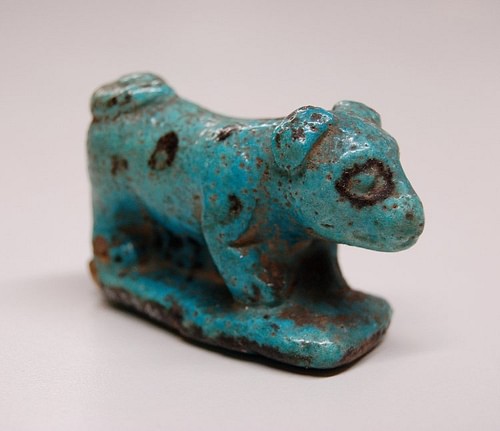
Egyptian Toy Domestic dog
Domestication & the Domestic dog
Animals such as cattle, sheep, goats, pigs, asses, and dissimilar kinds of birds were domesticated in the Pre-Dynastic Menstruum (c.6000 - c. 3150 BCE) as evidenced by grave appurtenances and overuse of the state for grazing. By the fourth dimension of the Early Dynastic Period (c. 3150-c. 2613 BCE) cattle were the nigh important creature and were regarded as objects of substantial wealth every bit made articulate through the Egyptian Cattle Count which was a course of calculating and collecting taxes.
Whether as hunters & companions or guards, police, or religious figures, the dog was a common feature of the ancient Egyptian landscape.
Prior to the domestication of any of these animals, however, is that of the domestic dog. Scholars have reached this conclusion based upon physical prove from graves every bit well as inscriptions and tomb paintings. The dog, either a Basenji, Greyhound, or Saluki, is frequently depicted helping to herd cattle, wearing a wide collar fastened with a bow at the dorsum of the neck.
Co-ordinate to historian Jimmy Dunn, dogs "served a role in hunting, equally baby-sit and police dogs, in military deportment, and every bit household pets" (1). The Egyptian word for domestic dog was iwiw which referenced their bark (Dunn, 1). Whether as hunters and companions or guards, police, or religious figures, the dog was a common characteristic of the ancient Egyptian landscape.
Egyptian Canis familiaris Breeds
Dogs are represented in Egyptian fine art work from the Pre-Dynastic Period forwards either every bit companions, at the chase, or in afterlife vignettes. They also appear on ceramics such as the siltstone palettes which were used in daily life (such as the Four Dogs Palette at the Louvre for cosmetics) or in ceremonies or commemorations (as with the Narmer Palette).
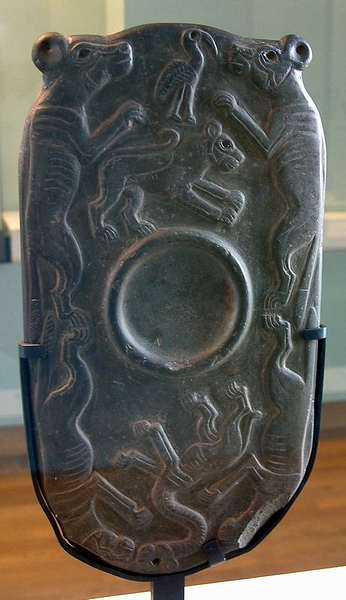
Four Dogs Palette
The kinds of breeds are sometimes hard to identify simply, essentially, seem to be of 7 distinct kinds. Hunting dogs were regularly referred to every bit tesem, a term which has attached itself to the ancestors of the Basenji, simply could take been applied as hands to whatsoever dogs used in the hunt.
A tesem was not a breed of dog just designated a hunting dog. The following breeds are identified past their modern names but it should exist understood that these were not the names they were known by in ancient Egypt except, perhaps, for the Basenji and Ibizan.
The Basenji: This breed is amid the best attested to in ancient Arab republic of egypt. It no doubt came from Nubia where it seems to have been quite common. The proper noun is usually translated as "dog of the villagers" because it was so commonly associated with communities of people. The Basenji was used in hunting small game and as a companion, family pet, and guard dog. Basenjis could be amidst the dogs on the funerary stele of Intef Two (2112-2063 BCE) of the 11th Dynasty and possibly his favorite dog, Beha, for whom he had an individual stele carved.
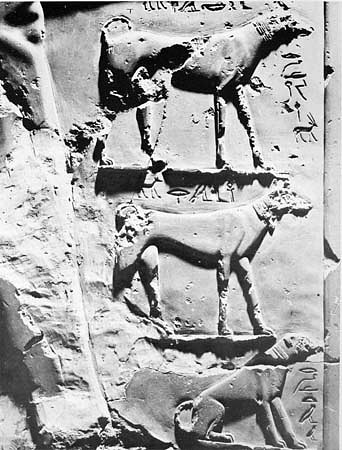
Dogs of Intef II
The Greyhound: Although the origin of the Greyhound is contested, prove of the breed has been constitute in both Mesopotamia and Egypt. Graves containing Greyhounds in Mesopotamia date back to the Ubaid Catamenia c. 5000 BCE and in Egyptian images c. 4250 BCE. The Greyhound was used in open up-area hunts for large game but was also kept as a pet and a guard domestic dog. Greyhounds are depicted throughout Egypt's history as a hunting canis familiaris only may likewise be the breed featured in boxing scenes like the Victory Stele of Ramesses II (1279-1213 BCE) celebrating his triumph over the Hittites at the Boxing of Kadesh.
The Ibizan: Probably the dog most frequently represented in Egyptian art. The Ibizan is of Egyptian origin but was brought from Arab republic of egypt to the island of Ibiza by Phoenician traders former in the 7th century BCE. The brood, and its name, is usually dated from this time simply there is no evidence of the dog on the isle of Ibiza originally while there is a great deal suggesting its presence in Arab republic of egypt. This is the dog most often referred to as the tesem and and then the 'typical' Egyptian dog.
The Pharaoh: This brood is routinely claimed to have originated much after, in the 17th century CE on Malta, but its ancestors are thought to have been kept past the ancient Egyptians. Most likely information technology was an Egyptian breed brought to Malta by Phoenician traders. This merits is based upon art work, such as that on the tomb of Intef 2 toward the end of the First Intermediate Catamenia (2181-2040 BCE). His funerary stele depicts dogs which resemble a breed like to the later pharaoh hound more than other known Egyptian breeds. The Pharaoh is frequently depicted in hunting scenes and was considered the best breed for sacrifice to Anubis at Cynopolis.

Egyptian Dog Types
The Saluki: First bred in Mesopotamia by the Sumerians, the Saluki was i of the most popular breeds in the region and, afterwards, in Arab republic of egypt. Amulets and fine art work in Mesopotamia regularly depict this brood and it has been found in graves with and without human remains accompanying the bones. The Saluki (or Sloughi brood) was definitely nowadays in Arab republic of egypt, in spite of claims to the reverse, just not as early as in Mesopotamia. Salukis are clearly represented in tomb paintings and stelae as hunting dogs and companions.
The Whippet: Whippets were the dogs of the Egyptian kings and most likely originated through the convenance of Greyhounds with pariah dogs. The consequence was a smaller, faster, hunting dog. Whippets were popular for hunting in open terrain where they could make the best use of their speed in bringing downward game. Although they are sometimes cited as a tardily brood in Egypt they seem to exist the dogs represented in fine art from the Erstwhile Kingdom onwards.
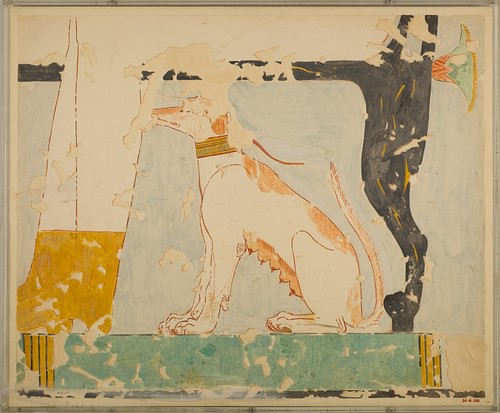
Seated Dog, Tomb of Nebamun
The Molossian: Bred in Greece in the region of Epirus, these dogs came to Egypt through trade. They take their name from the king of Epirus, Molossus, said to exist the grandson of Achilles. These dogs, or some variant of them, were well-known hunters and guard dogs in Mesopotamia and were used by the Egyptians for the same purpose but as well equally police dogs. They may be among the dogs, similar the greyhound, depicted on the Kadesh Victory Stele of Ramesses 2. The Molossus would afterward get best known as the fighting and state of war dogs of ancient Rome but seem to take become quite popular in Arab republic of egypt and were virtually probable introduced by the Hyksos in the Second Intermediate Flow (c. 1782-c.1570 BCE).
Information technology has been suggested that the presence of pariah dogs encouraged the Egyptian practice of burial in tombs to protect the remains.
There were also pariah dogs, wild dogs and strays of mixed breed, who ofttimes hunted effectually the outskirts of a village or necropolis. These dogs often traveled in packs and scavenged for food. Information technology has been suggested that the presence of pariah dogs encouraged the Egyptian practice of burying in tombs to protect the remains from them. In the early Pre-Dynastic Period the dead were cached in elementary earthen graves, often quite shallow, which allowed for the pariah dogs to easily dig down and disturb them. The mastaba tomb may have, in role, developed to forbid this.
Ancient Egyptian inscriptions mention the ketket only, like the tesem, this was non a breed of domestic dog just a clarification of a kind of dog. Ket means `niggling' in ancient Egyptian and then a ketket was whatever kind of pocket-sized dog. Dogs which seem to be the ancestors of the mod harrier also were kept by the Egyptians merely what this breed was is unknown. They seem to have been small or medium dogs of impressive speed.
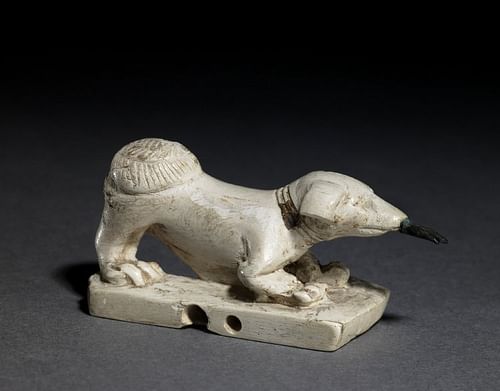
Egyptian Ivory Domestic dog
An example of a dog who would've been called a ketket is the small statue presently in the British Museum known every bit Dog Swallowing A Fish (detail number EA 13596) dated to the late 18th Dynasty c. 1350-1300 BCE. The statue shows a puppy "wearing a neckband which shows traces of gilding, with lop ears and a long bushy tail which curls effectually its hind quarters" and "adopts the well-known posture of a dog at play with front legs bent and rump raised in the air" (British Museum, 237). The dog holds a pocket-sized bronze object in its mouth which has been interpreted as either the tail of a fish or a large fly it is playing with. The slice is carved from tusk with the statuary attachment glued in identify on the mouth and two holes in its base of operations which most likely held the statue to a wall. The British Museum observes:
The slice is brilliantly observed and belongs to a class of small carvings fabricated towards the end of the 18th Dynasty which portrays animals that were familiar to and beloved by the Egyptians. It can have been fabricated for no other purpose than to delight and amuse its owner. (237)
Dogs & Anubis
Indeed, dogs were familiar and loved by the Egyptians. This devotion is clear from the number of times they are depicted and referenced in art and inscriptions throughout the history of the civilization and the mode they were generally treated.
As already noted, dogs were depicted on palettes in the Pre-Dynastic and Early on Dynastic periods. During the Quondam Kingdom, the dog of king Khufu (2589-2566 BCE), Akbaru, was said to have been buried in the rex'south tomb with him. 1 of the best known dogs of Egypt was given his own funeral stele in this same era. Abuwtiyuw was the dog of a servant of the king (though which Old Kingdom monarch is unclear) who was honored with a burying fit for a noble. The dog's stele reads:
The canis familiaris which was the guard of His Majesty. Abuwtiyuw was his proper name. His Majesty ordered that he be buried ceremonially, that he be given a bury from the royal treasury, fine linen in neat quantity, and incense. His Majesty also gave perfumed ointment and ordered that a tomb exist built for him by the gangs of masons. His Majesty did this for him in order that he [the dog] might be honored before the bang-up god, Anubis. (Hobgood-Oster, 41-42)
The Basenji is the most often cited as the inspiration for the image of Anubis, one of the principal gods of the dead who guided the soul to judgment in the afterlife (although the Greyhound, Pharoah, and Ibizan are likewise contenders). Anubis is frequently referred to as "the jackal canis familiaris" but this is not how he was known to the aboriginal Egyptians where he is always referenced as a dog equally in his epithet "the dog who swallows millions". It should be noted, however, that the Egyptians did not distinguish between the jackal and the dog, specially then with pariah dogs.
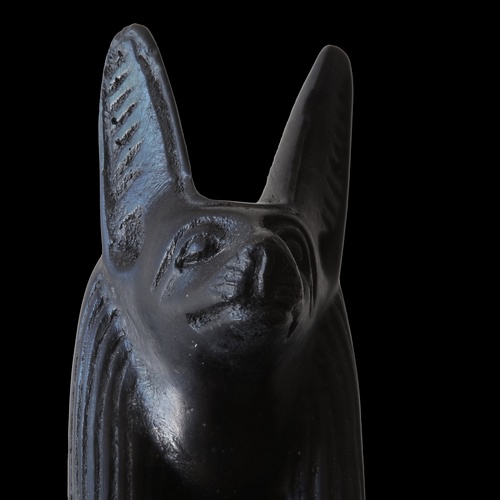
Anubis God of Lost Souls
The town of Hardai was the cult center of Anubis and and so was called Cynopolis ("City of the Dog") by the Greeks. Hither dogs freely roamed through Anubis' temple and were likewise bred for sacrifice. Mummified dogs were brought to the temple as offerings to Anubis (the "cherry domestic dog", identified with the Pharaoh brood, existence preferred) but the expiry rate of the temple dogs was not high plenty to meet the demand for mummified sacrifices. A kind of puppy manufactory was initiated for the sole purpose of breeding dogs for sacrifice to Anubis.
Dogs, Collars, & the Afterlife
Nether ordinary circumstances, however, killing a dog carried severe penalties and, if the dog was collared and clearly owned by some other, its murder was a capital crime. The death of a family unit dog elicited the same grief equally for a human and the family unit members would shave their bodies completely, including the eyebrows. As most Egyptian men and women shaved their heads to avoid lice and maintain bones hygiene, the absence of the eyebrows was the most notable sign of grief. In some periods the opposite was observed and people would non shave at all.
Even so, simply as with the mourning of the expiry of a human being, it was believed that one would encounter i'southward canine friend again in the afterlife. Tomb paintings of the pharaoh Tutankhamun show him in his chariot with his hunting dogs and Rameses the Great is depicted similarly. Equally in the case of Khufu and his companion, dogs were oftentimes cached with their masters in club to accompany them closely in the afterlife. Some dogs seem to have been killed after the decease of their primary and and so mummified while others died earlier and still others, as at Cynopolis and perhaps at Saqqara, were ritually sacrificed.
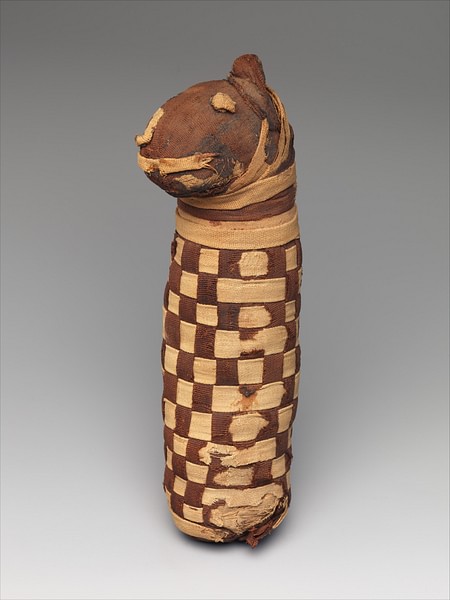
Egyptian Canis familiaris Mummy
Equally in many other cultures, before and later, the canis familiaris was seen as a kind of intermediary betwixt worlds who could act every bit a guide; this is nearly clearly seen in the image of the dog-god Anubis. The dog who aided and guided one in life would serve the same purpose in the afterlife. The intimate relationship between dogs and their masters in Egypt is fabricated articulate through inscriptions in tombs, monuments, and temples and through Egyptian literature. Dogs, unlike cats, were always named and these names were inscribed on their collars. Dunn writes:
We even know many ancient Egyptian dog'south names from leather collars every bit well equally stelae and reliefs. They included names such as Brave One, Reliable, Good Herdsman, North-Wind, Antelope and even "Useless". Other names come up from the domestic dog's color, such every bit Blacky, while withal other dogs were given numbers for names, such as "the Fifth". Many of the names seem to correspond endearment, while others convey simply the dog'south abilities or capabilities. (Dunn, ii)
These domestic dog collars well-nigh likely began in the early periods equally simple rope, probably like to the sideslip-leads used today, but evolved over time into intricate works of art. Already by the Sometime Kingdom the neckband was a thick leather band glued together and pulled over a domestic dog's caput. During the Middle Kingdom these collars became more than elaborate and were often adorned with copper and bronze studs. In the New Kingdom (c. 1570-1069 BCE) the dog collar reached its height with gold and silver collars inscribed with the dog's proper noun.
Two specially interesting pieces from this period come from the tomb of Maiherpri, a noble during the reign of Thutmose IV (1400-1390 BCE), whose proper noun translates as "Panthera leo of the Battlefield" and then was patently regarded equally a smashing warrior. In improver to his quiver, wrist guards, and arrows in the tomb were two dog collars which are dyed pink and intricately adorned with images. One is ornamented with images of lotus flowers and horses punctuated past brass studs while the other depicts dogs hunting ibex and gazelle and includes the proper noun of the dog, Tantanuit, which suggests this dog was female person every bit "Tantanuit" was a adult female's name.
Leashes, throughout Arab republic of egypt'south history, were either leather or papyrus rope. A canis familiaris collar excavated from a grave in modernistic Sudan at the site of the necropolis of Tombos, dated to the New Kingdom, is a leather band with a diamond-shaped terminus which was fitted into a slit cut in the collar; the remaining length of the leather was then used as a leash.
The devotion of people to their dogs, and the affection the dogs returned, continued in the afterlife where it was believed one plant all that had seemingly been lost at death. In one case the soul had been justified by Osiris and allowed to move on, one would travel to the Field of Reeds which was an arcadian version of the life ane had left behind on earth. All of the loved ones who had gone on before would greet the soul as information technology stepped into this realm and there would be the same house, the garden, the stream one had enjoyed in life and, with them, souls would again find their favorite dog faithfully awaiting their inflow home.
This article has been reviewed for accuracy, reliability and adherence to academic standards prior to publication.
Source: https://www.worldhistory.org/article/1031/dogs-in-ancient-egypt/
0 Response to "Ancient Egypt Cats Thanks for Watching Word Art Egypt"
Post a Comment